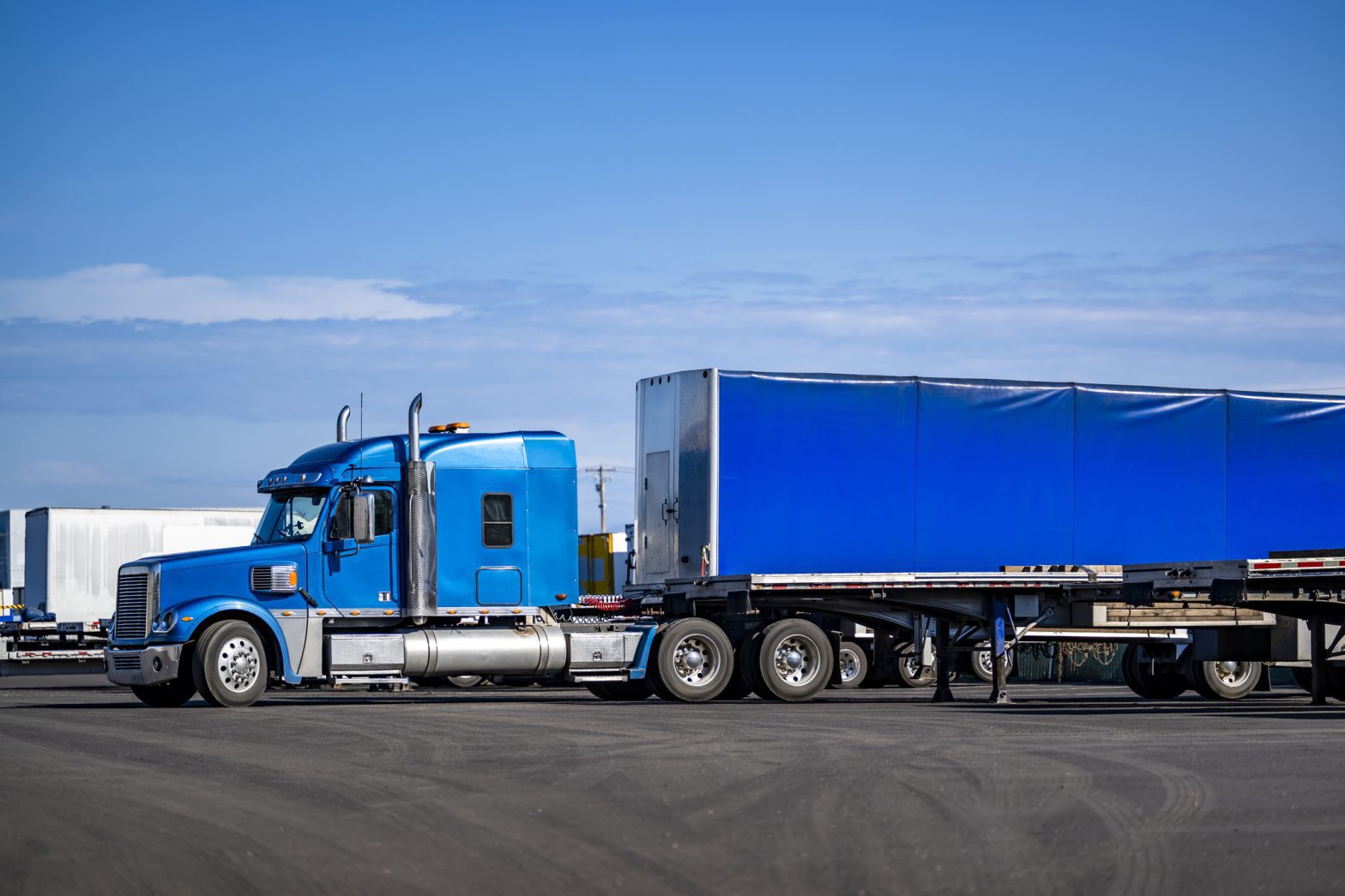
 July 1, 2024
July 1, 2024
Trucking Logistics Terminology: 45 Terms You Need to Know
Mastering the terminology of trucking logistics terms is essential for navigating the complexities of the industry effectively. With First Frontier Logistics as your partner, you gain access to expertise and resources that streamline your transportation needs between Canada, the USA, and Mexico. Contact us today to leverage our experience and ensure seamless freight movement across borders. Let’s drive your business forward together. Get a Quote now!
Essential Terms in Trucking Logistics
- Freight: Refers to goods or cargo being transported by trucks from one location to another. It can include anything from consumer goods and electronics to raw materials and machinery.
- Carrier: A company or individual responsible for transporting freight via trucks. Carriers can range from large trucking companies to independent owner-operators.
- Dispatcher: An individual tasked with scheduling and coordinating truck movements to ensure timely delivery of goods. Dispatchers play a crucial role in optimizing routes, managing driver schedules, and responding to unexpected events.
- Dispatch: The process of assigning drivers and trucks to specific loads and routes, coordinated by dispatchers to optimize efficiency and meet customer demands. Dispatchers communicate with drivers, shippers, and receivers to ensure timely delivery and resolve any issues that may arise during transit.
- LTL (Less Than Truckload): A shipment that does not require a full truck for transportation, often combined with other shipments to maximize truck capacity. LTL shipments are common for smaller loads.
- FTL (Full Truckload): A shipment that utilizes the entire capacity of a truck, typically for larger quantities of goods. FTL shipments are preferred when a shipper has enough goods to fill an entire truck or if you do not want other freight on the truck with their product.
- Bill of Lading (BOL): A legal document that details the type, quantity, and destination of goods being transported, serving as a receipt of shipment. It also serves as a contract between the shipper, carrier, and recipient.
- Proof of Delivery (POD): A document signed by the recipient of goods to confirm receipt and completion of delivery, often used as evidence of successful delivery and invoicing. POD documents may include details such as the date and time of delivery, condition of goods, and recipient’s signature. The BOL can frequently act as the POD once signed at final delivery.
- Pedimento: A customs declaration document required for importing goods into Mexico. It includes details such as the importer and exporter information, description of goods, value, and taxes. This is crucial for moving goods across the border. For more info on Pedimento requirements Click Here
- Carte Porte: Refers to a document issued by a freight carrier or transport company, serving as a permit or authorization for the carriage of goods by road. The Carte Porte is legally required by Mexican officials for all shipments moving in Mexico. This document typically contains essential details such as the origin and destination of the goods, the type and quantity of cargo being transported, as well as any relevant terms and conditions of carriage. As a newer document for Mexico, the Carte Porte is still evolving in its complete requirements and how it must be presented/ filed with the Mexican authorities.
- Payload: The maximum weight of cargo that a truck or trailer can carry, excluding the weight of the vehicle itself. Payload capacity varies depending on the size and configuration of the truck or trailer.
- Dock: A designated area at a warehouse or terminal where trucks load and unload goods. Docks are equipped with ramps or levelers to facilitate the movement of goods between trucks and warehouse facilities.
- Terminal: A facility equipped with loading docks and other amenities for the handling of freight and coordination of truck movements. Terminals may also offer services such as warehousing, cross-docking, and trans-loading.
- Detention: A fee charged from carriers when their trucks are held at a dock for an extended period beyond the agreed-upon time for loading or unloading. Detention fees compensate carriers/drivers for lost time and productivity caused by delays at the dock.
- Freight Rate: The price charged by the transportation company for transporting goods, usually calculated based on factors such as distance, weight, and type of cargo. Freight rates may vary depending on market conditions, fuel prices, and other factors.
The Vital Role of Trucking Logistics in North America
Trucking logistics is the lifeblood of North American commerce, ensuring the seamless movement of goods across the vast continent. It connects manufacturers, retailers, and consumers, enabling efficient supply chains that support economic growth. The industry plays a critical role in meeting the demands of businesses and households. From essential goods to high-value products, trucking logistics is indispensable in maintaining the flow of trade, driving innovation, and supporting the overall infrastructure of the North American economy.

- Consolidation: The process of combining multiple smaller shipments into a single larger shipment to optimize truck capacity and potentially reduce transportation costs. Consolidation allows shippers to take advantage of FTL rates and minimize the number of shipments.
- Expedited Shipping: A service that prioritizes the rapid delivery of goods, often used for time-sensitive or urgent shipments that require faster transit times. Expedited shipping services may include guaranteed delivery times and dedicated transportation resources.
- Linehaul: The long-distance transportation of goods between major cities or distribution centers, typically conducted by trucking companies specializing in intercity routes. Linehaul carriers focus on transporting goods over long distances efficiently and reliably.
- Reefer Truck: A refrigerated truck equipped with temperature-controlled units for transporting perishable goods. Reefer trucks are essential for maintaining the freshness and quality of items such as food, pharmaceuticals, and chemicals.
- Dry Van: An enclosed truck trailer used for transporting general cargo, offering protection from weather and theft. Dryvans can be different sizes, but the most common is 53′. Dry vans are versatile and commonly used for a wide range of goods, including consumer products, electronics, and automotive parts.
- Flatbed: Refers to a type of trailer equipped with an open cargo area without sides or a roof, allowing for the transportation of oversized or unconventional cargo that cannot be easily accommodated in enclosed trailers.
- Bobtail: A truck operating without a trailer attached, often used for local deliveries or short hauls. Bobtail trucks are typically used when a truck needs to return to its home base or pick up a new load.
- Deadhead: Refers to the movement of a truck without any cargo, typically to return to a home base or pick up a new load. Deadhead miles represent inefficiencies in the transportation process and are a consideration for carriers and drivers.
- Hours of Service (HOS): Regulations that limit the number of hours a truck driver can operate within a specified period to ensure safety and prevent driver fatigue. HOS regulations are enforced by government agencies and are designed to reduce the risk of accidents caused by tired or overworked drivers. For more information regarding hours of service check out these links Canada, United States
- Electronic Logging Device (ELD): A device installed in trucks to automatically record driving time and monitor compliance with HOS regulations. ELDs replace traditional paper logbooks and provide accurate, real-time data on driver hours and duty status.
- Hazmat: Abbreviation for hazardous materials, which require special handling and transportation regulations due to their potential to pose risks to health, safety, and the environment. Hazmat shipments must comply with strict regulations governing packaging, labeling, and transportation.
- Insurance Certificate: A document that provides proof of insurance coverage for liability and cargo, often required by shippers and carriers to protect against potential losses. In many countries it is mandatory to hold a minimum insurance coverage to operate. Insurance certificates demonstrate that the transportation company has adequate insurance coverage to protect against liability claims, damage to cargo and other liabilities.
- Freight Class: A classification system used to categorize goods based on their density, stowability, handling, and liability, determining the shipping rate for LTL shipments. Freight classes range from class 50 (light, dense items) to class 500 (bulky, heavyweight items) and can affect the rates charged for many large LTL carriers.
- Distribution Center: A facility used for storing, sorting, and distributing goods to their final destinations, serving as a crucial link in the supply chain. Distribution centers play a key role in managing inventory, fulfilling orders, and ensuring timely delivery to customers.
- 3PL Network: A Third-Party Logistics (3PL) network connects businesses with logistics service providers specializing in various aspects of supply chain management, which can include transportation, warehousing, and distribution. This network enables businesses to access a wide range of logistics services and expertise, facilitating seamless and efficient supply chain operations.
- 4PL Platform: A Fourth-Party Logistics (4PL) platform serves as a comprehensive logistics solution provider, managing and optimizing all aspects of a supply chain on behalf of clients. This platform integrates multiple third-party logistics (3PL) providers and direct carriers to leverage advanced technologies to deliver end-to-end supply chain visibility, efficiency, and potential cost savings
Trucking in North America : The Essential Impact
Trucking logistics is a cornerstone of North America’s economy, facilitating the transport of nearly 11 billion tons of freight annually. This industry not only supports the supply chain of countless businesses but also ensures the timely delivery of critical goods, from medical supplies to food products and everything in between. Employing over 3.5 million truck drivers, trucking logistics is a major contributor to job creation and economic stability. The adaptability and extensive reach of the trucking network make it an indispensable component of the region’s trade infrastructure, driving commerce and connecting communities across diverse geographies.

- Owner-Operator: A truck driver who owns and operates their own trucking business, often contracting their services to carriers, shippers or 3PLs. Owner-operators are usually responsible for managing their equipment, finding loads, and handling administrative tasks.
- Freight Broker: A company that arranges transportation services between shippers and carriers, often negotiating rates and coordinating logistics. Freight brokers help connect shippers with carriers that can meet their specific transportation needs.
- Freight Forwarder: A company that specializes in organizing and managing the transportation of goods on behalf of shippers, handling logistics and documentation. Freight forwarders may offer a range of services, including customs clearance, insurance, and supply chain management. This term pertains to international in most cases.
- Drop and Hook: A logistics strategy where a truck drops off one trailer at a designated location and picks up another preloaded trailer for delivery, minimizing downtime and optimizing efficiency. Drop and hook operations reduce waiting times at docks and allow carriers to keep trucks moving.
- Over-the-Road (OTR): Refers to trucking operations that involve long-distance travel across state lines or between regions, often requiring overnight stays in sleeper cabs. OTR drivers cover extensive distances and may spend extended periods away from home.
- Team Driving: A practice where two truck drivers take turns operating a single truck to maximize driving hours and minimize downtime, often used for expedited or time-sensitive deliveries. Team drivers can cover more miles in less time and maintain continuous operation of the vehicle.
- Hazmat Tanker Endorsement: A certification is required for truck drivers who transport hazardous materials, demonstrating their knowledge of safety procedures and regulations governing hazmat transportation. Hazmat endorsements are obtained by passing a written exam and background check.
- Cross-Docking: A logistics strategy that involves transferring goods directly from inbound trucks to outbound trucks with minimal or no warehousing, allowing for faster distribution and reduced handling costs. Cross-docking facilities serve as transit points for consolidating and sorting freight before onward shipment.
- Backhaul: A return trip in which a truck carries cargo back to its point of origin after delivering its primary load, maximizing efficiency and reducing empty miles. Backhaul opportunities allow carriers to generate additional revenue and optimize truck utilization.
- Carrier Liability: The legal responsibility of a carrier for the safe and timely delivery of goods entrusted to them, including compensation for loss, damage, or delay. Carrier liability is outlined in the terms and conditions of the bill of lading and may vary depending on the type of shipment and applicable regulations.
- Tariff: A document containing the rates, rules, and terms of service for transportation services provided by carriers, often used to establish pricing and contractual agreements. Tariffs outline the rates for various services, surcharges, and special conditions governing the transportation of goods.
- Rate Confirmation: A document issued by a company confirming the agreed-upon rate and terms for transporting goods, serving as a contractual agreement between the transportation provider and shipper. Rate confirmations provide details such as pickup and delivery locations, freight charges, and payment terms.
- Delivery Appointment: A scheduled time window for the delivery of goods to a specific location, coordinated between the carrier and recipient to ensure efficient delivery operations. Delivery appointments help manage dock congestion, minimize wait times, and improve customer service.
- EDI Platform: An Electronic Data Interchange (EDI) platform facilitates the electronic exchange of business documents, such as purchase orders and invoices, between trading partners. This platform automates data transmission, improving accuracy and efficiency in supply chain communication and transaction processing.
Conclusion:
Trucking Logistics serves as the backbone of global commerce, facilitating the movement of goods across vast distances efficiently and reliably. Whether you’re a seasoned professional or just dipping your toes into the industry, understanding the terminology is crucial. We’ve compiled 45 essential trucking logistics terms for the transportation industry, providing comprehensive explanations to broaden your knowledge base and enhance your understanding of this dynamic field.






